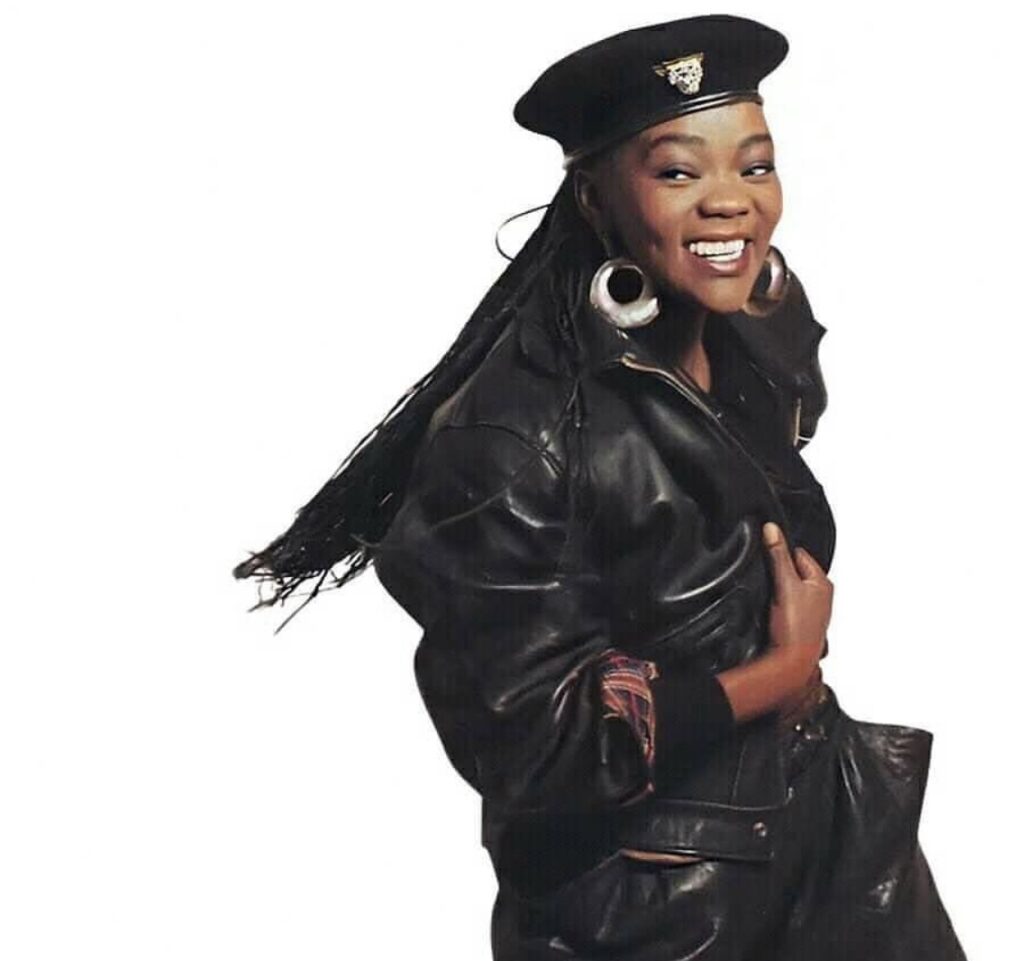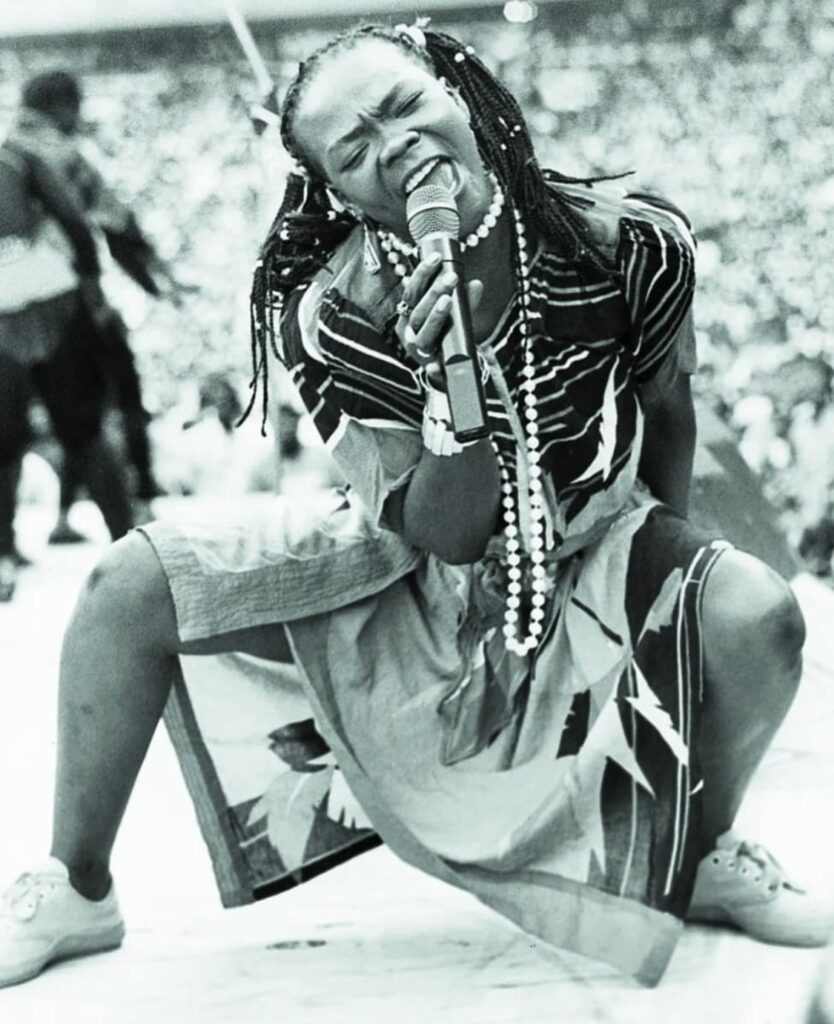Brenda Fassie, The Madonna of the Townships MaBrrr as she was fondly called by fans…where do we even begin? Her story begins in a place in Cape Town called Langa. There, she was born and named after the singer Brenda Lee. It’s almost as if her parents could see her becoming a force in the entertainment industry. Music came easily to her as her mum was a pianist and her dad was a tap dancer.
Brenda Fassie started singing at a very young age. I believe those pipes had to have been groomed early. If you’ve heard her sing, then you’d know what I’m talking about. She had a very powerful voice that sent her audience chills from the very first note. Her mother often joked that Brenda came out singing and humming as soon as she was born. As for how Brenda found her way to fame, let’s take a look at her early singing years and music career.

Brenda Fassie and Joy
Fassie always knew she could sing, and she was so eager to show the world what she had even as an early teen. She earned money by singing for tourists, and soon enough, she had people’s attention. At first, a producer, Koloi Lebona, approached Brenda’s mother. He wanted to make a career out of her beautiful voice, but Brenda’s mother turned him down. Just like any mother, she still thought of Brenda as her little baby. Brenda, on the other hand, had just entered her teenage rebellious phase. She, of course, wasn’t going to let that opportunity slip away, so she ran away from home at 16. Little Brenda hitchhiked, got on a truck, and went all the way from Capetown to Soweto, where she lived with Lebona’s family.

She joined a trio band named Joy as a substitute singer, further molding her career. Brenda described that period as very nurturing and important to her. The other members of the band were all older than her, but they treated her like family. A lot of things Brenda Fassie learned about music and womanhood, she learned from them, and she often described them as her mothers.
After that, she joined Blondie and Papa on their roadshow, and that subsequently took her career up a few notches due to the publicity she got from it.
Brenda and The Big Dudes

MaBrrr’s career had taken off. She was now the lead singer of the music group Brenda and the Big Dudes. They had a funny name, witty lyrics, and great music. A gem from this group that sold hundreds of thousands of copies is the song, “No, No, No Senor”.
I used to love watching the video all those years back. It didn’t matter whether Brenda Fassie sang in English, Zulu, or Xhosa, I still loved and enjoyed every bit of her art. And so did everyone.
Brenda’s son
In 1985, she had a son with one of the “Big Dudes” and shortly after, left the group. Brenda’s son, Bongani Fassie, didn’t fall too far from the Fassie tree, he also grew up loving music. Brenda loved her son as much as any mother would. She often took pride in letting him chip in during her interviews. “This boy is going to be a star, I know it.” Bongani did row up to become a musician, though not one as great as his mother was, but a musician nonetheless.

After Brenda left The Big Dudes, they convinced themselves they didn’t need her and tried to survive on their own. They even released a song after she left, “You’ll be coming back”, sure of her return to the group. She didn’t, and their career failed while hers soared.
One thing that is worthy of mention, though, is Brenda Fassie and her undying love for her country. That powerful voice of hers wasn’t just for Bubblegum music, but also to voice out opinions about political crises in South Africa. One famous song from this era was “My Black President”, an ode to Nelson Mandela, who was in prison at the time.

Brenda yearned for when he’d come out and lead his people again, and she sang about it as loudly as she could. She had a close relationship with Nelson Mandela and also with the later president of South Africa, Thabo Mbeki.

Brenda and The Press
After Brenda Fassie’s divorce from her short-lived marriage, it seemed the press had taken a hold of every little detail of her life. Brenda’s life was constantly under scrutiny, from her publicized wedding to the divorce. Even to opinions about her personality and her sexual orientation, as she was attracted to both sexes.

One thing Brenda made clear was that she was determined to live for no one but herself. In a typical interview with Brenda, you’d see her holding a lit cigarette and a glass of something in one hand, laughing out loud at some ridiculous accusation the press was always making. In her own words;
“I like to create controversy; it’s my trademark”
She thrived on those stories, always insisting that they made her bigger. It was a love-hate relationship with the press because, as much as they constantly berated her, Brenda Fassie maintained her stand that she would not be where she was without them. They gave her both good and bad publicity, and she was grateful for all of it. She said, “Thank you to the media, for making and breaking me”.
Brenda and The Drugs
This is the part of Brenda’s story where it gets quite unsavory. As much as Brenda Fassie was a fearless queen who did whatever she wanted, she had her demons. Unfortunately, she often turned to drugs to hide from them. She found solace in her music and in drug use. In the lyrics to one of her songs, Brenda wrote “I’m always looked at, but not into.” This brushed on just how she felt misunderstood by the public.

As any story of drug use goes, it soon got out of hand. As expected, this took its toll on her music. It seemed as if the queen’s era had come to an end. In 1995, she was found in a hotel room with her partner, who had overdosed on cocaine and died. After that, Brenda Fassie checked into a rehab center and decided to get her career back on track. It seemed like she was saying to all those critics who thought she was over, “hold my beer” (literally)The next projects she released topped the charts with thousands of sales. She produced an album, “Now Is The Time,” featuring Papa Wemba. In 1998 she released yet another album, “Memeza” which became the best-selling South African music project of the year.

The end of MaBrrr
Unfortunately for the Black Madonna, the drugs came back time and time again, and they eventually brought an end to the life of Brenda Fassie. In May 2004, she slipped into a coma and was pronounced dead about a week later when she was taken off life support.
In life and death, the iconic queen bagged so many awards as proof that she was every bit as talented as she thought she was. Some of Brenda’s several awards include five South African Music Awards (SAMA’s), three Kora awards, and so much more. Among all her iconic recognitions, one stands out, a life-sized bronze sculpture of Brenda that can be seen outside Bassline in Johannesburg.
Brenda Fassie was fearless in her lifetime and, even with so much controversy surrounding her lifestyle, her music spoke to thousands of people, just as she intended.







3 Comments
Nora
September 7, 2022 at 10:01 am
If this story was longer, I’d still be reading.
I didn’t stop till I was done! Beautiful writing
Ugochi Anuonye
September 8, 2022 at 4:46 pm
Thank you, Nora!
Rishama Madaki
September 17, 2022 at 10:20 am
Thank you Nora!